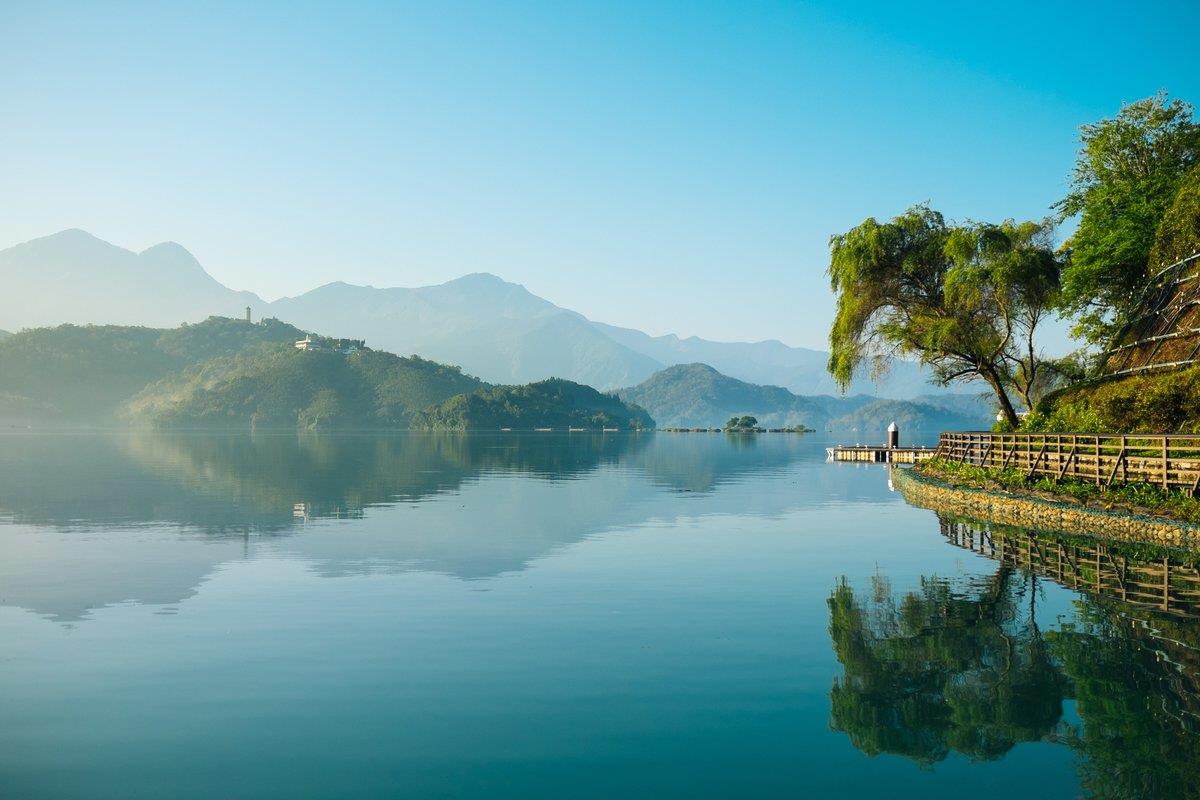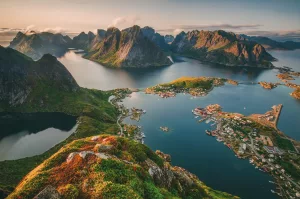Nestled in the heart of Taiwan’s central mountain range, Sun Moon Lake is one of the island’s most iconic and captivating destinations. This stunning body of water, the largest in Taiwan, is not only a natural wonder but also a place deeply imbued with cultural and historical significance. Its poetic name derives from the lake’s unique shape—one side resembles a sun, while the other side curves into the shape of a crescent moon. But beyond its picturesque appearance, Sun Moon Lake holds a rich tapestry of stories, legends, and cultural practices that have been woven into the lives of the people who live there. This article delves into the multifaceted allure of Sun Moon Lake, exploring its history, cultural heritage, ecological significance, and the modern-day challenges of balancing tourism with preservation.
1. The Historical and Cultural Legacy of Sun Moon Lake
Origins and Early Cultural Significance
Sun Moon Lake has been a place of reverence and importance long before it became a popular tourist destination. The area around the lake has been inhabited for centuries, most notably by the Thao people, one of Taiwan’s indigenous tribes. The Thao people have a deep spiritual connection to Sun Moon Lake, which they believe was created by a divine white deer. According to Thao legend, the tribe was led to the lake by this sacred deer, which guided them through the mountains to this fertile and bountiful land. The Thao settled around the lake, and it became central to their culture, providing not only sustenance but also a spiritual anchor.
The Thao’s connection to Sun Moon Lake is evident in their rituals, festivals, and oral traditions. The lake is considered a living entity, imbued with spiritual significance, and is often featured in Thao myths and stories. For the Thao people, the lake represents life, prosperity, and a sacred bond with the natural world. Their annual rituals, such as the “Fishing Festival,” which celebrates the bounty of the lake, and the “Full Moon Festival,” which honors the moon’s reflection on the water, are a testament to their enduring relationship with Sun Moon Lake.
Colonial Influence and Modernization
The historical trajectory of Sun Moon Lake took a significant turn during the Japanese occupation of Taiwan from 1895 to 1945. Recognizing the lake’s natural beauty and strategic importance, the Japanese colonial government initiated several development projects that would transform Sun Moon Lake into a modern attraction. One of the most significant projects was the construction of a hydroelectric power plant, which harnessed the water from the lake to generate electricity for the region. This project not only brought modernization to the area but also altered the landscape of the lake, raising its water level and submerging parts of the surrounding land.
During this period, the Japanese also promoted Sun Moon Lake as a tourist destination. They built infrastructure such as roads, hotels, and viewing platforms to accommodate the influx of visitors, including Japanese officials and dignitaries who sought respite in the tranquil environment. The Japanese influence is still visible today in the architectural styles of some buildings around the lake, as well as in the carefully landscaped gardens and shrines that dot the area.
One of the most notable legacies of the Japanese period is the Sun Moon Lake Wenwu Temple. Originally built during the Qing Dynasty, the temple was relocated and reconstructed by the Japanese to accommodate the rising water levels caused by the hydroelectric project. Wenwu Temple, dedicated to Confucius and the martial gods Guan Gong and Yue Fei, is a striking example of how cultural and religious practices were adapted and preserved even amid significant environmental changes.
2. Cultural Significance and Modern-Day Practices
The Thao People and Their Enduring Culture
Despite the changes brought by colonialism and modernization, the Thao people have managed to preserve their cultural heritage and maintain their connection to Sun Moon Lake. Today, the Thao are recognized as one of Taiwan’s official indigenous peoples, and their cultural practices are celebrated and protected. The village of Ita Thao, located on the shores of the lake, serves as a cultural hub where visitors can learn about Thao traditions, crafts, and cuisine.
The Thao people continue to perform their traditional rituals and festivals, many of which are centered around the lake. The Sun Moon Lake Full Moon Festival remains one of the most significant cultural events, drawing both locals and tourists to witness the traditional dances, music, and ceremonies that honor the lake and the natural world. These festivals not only preserve the Thao’s cultural heritage but also help foster a sense of community and continuity in an increasingly modern world.
The Thao have also adapted to the demands of modern tourism, offering cultural tours, craft workshops, and performances that allow visitors to engage with their traditions in meaningful ways. Through these activities, the Thao people share their deep connection to Sun Moon Lake and educate visitors about the importance of preserving both their culture and the natural environment.
Temples and Religious Significance

Sun Moon Lake is not only a cultural and spiritual center for the Thao people but also for many other communities in Taiwan. The lake is surrounded by several important temples and religious sites that attract pilgrims and tourists alike. Each temple around the lake has its unique history and significance, contributing to the spiritual atmosphere that pervades the area.
Wenwu Temple is perhaps the most famous of these religious sites. Located on the northern shore of Sun Moon Lake, the temple is an impressive structure with grand staircases, ornate carvings, and beautiful views of the lake. The temple is dedicated to Confucius, the revered philosopher and teacher, and to Guan Gong and Yue Fei, two deified historical figures known for their loyalty and martial prowess. Pilgrims visit Wenwu Temple not only to pay respects to these figures but also to seek blessings for academic success, martial prowess, and protection. The temple’s architecture is a blend of traditional Chinese design elements with influences from Japanese temple construction, reflecting the historical layers of the region. Visitors often participate in rituals such as writing wishes on wooden plaques and hanging them in the temple, a practice believed to bring good fortune.
Another significant religious site at Sun Moon Lake is Xuanzang Temple, located on a hill overlooking the lake. This temple is dedicated to the famous Tang Dynasty monk Xuanzang, who journeyed to India in the 7th century to obtain sacred Buddhist scriptures. The temple houses a relic of Xuanzang and serves as a pilgrimage site for Buddhists. The serene atmosphere of the temple, combined with its panoramic views of the lake, makes it a place of quiet reflection and spiritual contemplation.
Sun Moon Lake is also home to the Ci’en Pagoda, built in 1971 by Chiang Kai-shek in memory of his mother. The pagoda stands 46 meters tall on the southern shore of the lake, offering visitors a chance to climb to the top for breathtaking views of the surrounding landscape. The pagoda, with its traditional Chinese architectural style, adds to the cultural richness of the area and serves as a symbol of filial piety, a core value in Chinese culture.
3. Natural Wonders and Ecological Importance
Biodiversity and Conservation
Sun Moon Lake is not only a cultural treasure but also an ecological haven, boasting a rich diversity of flora and fauna. The lake and its surrounding mountains are part of a unique ecosystem that supports a wide range of species, some of which are endemic to Taiwan. The waters of Sun Moon Lake are home to various fish species, including the endemic Formosan landlocked salmon, a relic from the Ice Age that has adapted to freshwater conditions.
The lake’s surrounding forests are equally diverse, providing habitat for numerous bird species, including the black bulbul, grey-cheeked fulvetta, and Taiwan blue magpie, Taiwan’s national bird. The forests also support a variety of butterflies, including the rare purple crow butterfly, which migrates to the area in large numbers during certain times of the year. This incredible biodiversity makes Sun Moon Lake a destination for nature enthusiasts and birdwatchers.
In addition to its rich biodiversity, Sun Moon Lake plays a crucial role in water conservation and climate regulation for the region. The lake is fed by numerous small streams and rivers from the surrounding mountains, and it serves as a vital water reservoir for the central part of Taiwan. Efforts to conserve the lake’s water quality and protect its natural surroundings are ongoing, with various government and local initiatives in place to manage pollution, prevent soil erosion, and maintain the ecological balance.
Scenic Beauty and Outdoor Activities
The natural beauty of Sun Moon Lake is one of its most compelling attractions, drawing visitors from around the world to experience its tranquil waters and lush surroundings. The lake’s surface is often described as mirror-like, reflecting the surrounding mountains and forests in a perfect tableau of nature’s beauty. The contrast between the deep blue of the lake and the verdant green of the mountains creates a scene of breathtaking tranquility.
One of the best ways to experience the natural beauty of Sun Moon Lake is by taking a boat tour. These tours typically stop at key sites around the lake, such as Lalu Island, which is considered sacred by the Thao people, and Ita Thao Village, where visitors can learn about indigenous culture. Boating on the lake provides a unique perspective, allowing visitors to appreciate the scale and serenity of the area.
For those who prefer land-based activities, the Sun Moon Lake Bikeway offers a scenic route around the lake, winding through forests, across bridges, and along the shoreline. The bikeway is well-maintained and provides stunning views at every turn, making it a favorite among cyclists and hikers alike. The route varies in difficulty, catering to both casual cyclists and more experienced riders, and offers plenty of spots to stop and take in the views.
Hiking is another popular activity, with several trails around the lake leading to viewpoints, temples, and natural attractions. The trails vary in length and difficulty, allowing visitors to choose routes that match their fitness levels and interests. Whether it’s a leisurely walk along the lakeshore or a more challenging hike up one of the surrounding mountains, the experience of being immersed in nature is always rewarding.
4. Tourism and Its Impact on the Local Economy
Growth of Tourism
Over the decades, Sun Moon Lake has become one of Taiwan’s most popular tourist destinations, attracting millions of visitors annually. The combination of natural beauty, cultural heritage, and recreational opportunities makes it a must-visit location for both domestic and international tourists. The local economy has flourished as a result, with a wide range of businesses catering to the needs of visitors, including hotels, restaurants, souvenir shops, and tour operators.
The influx of tourists has led to the development of various attractions designed to enhance the visitor experience. In addition to boat tours and cycling paths, the area now boasts cable cars that provide panoramic views of the lake and surrounding mountains, as well as theme parks that offer family-friendly entertainment. These developments have helped to diversify the local economy and create jobs, contributing to the prosperity of the region.
Challenges of Sustainable Tourism
While tourism has brought economic benefits to Sun Moon Lake, it has also presented challenges, particularly in terms of environmental sustainability and the preservation of cultural heritage. The high volume of visitors has led to concerns about pollution, habitat destruction, and the potential degradation of the lake’s natural beauty. Additionally, the commercialization of cultural sites and traditions has raised questions about the impact on the authenticity and integrity of local culture.
To address these challenges, there has been a growing emphasis on sustainable tourism practices. Efforts are being made to manage the number of visitors during peak seasons, reduce waste and pollution, and promote eco-friendly transportation options such as electric boats and bicycles. Conservation projects are also in place to protect the lake’s water quality and biodiversity, ensuring that the natural environment remains intact for future generations.
Local communities and government agencies are working together to balance the needs of tourism with the preservation of Sun Moon Lake’s cultural and natural heritage. This includes initiatives to support the Thao people in maintaining their cultural practices while also participating in the tourism economy. By promoting responsible tourism, Sun Moon Lake aims to remain a vibrant and sustainable destination that continues to offer its unique blend of natural beauty and cultural richness.
Conclusion
Sun Moon Lake is a place where nature, culture, and history converge in a harmonious and captivating way. From its origins as a sacred site for the Thao people to its development as a major tourist destination, the lake has maintained its allure and significance through the centuries. Today, Sun Moon Lake continues to enchant visitors with its stunning landscapes, rich cultural heritage, and the promise of adventure and discovery.
Whether you are drawn to its tranquil waters, the spiritual atmosphere of its temples, or the opportunity to explore Taiwan’s natural wonders, Sun Moon Lake offers an experience that is both enriching and unforgettable. It stands as a testament to the enduring connection between people and place, a symbol of Taiwan’s cultural diversity and natural splendor. By embracing sustainable practices and honoring the lake’s cultural legacy, Sun Moon Lake will continue to inspire and captivate for generations to come.




